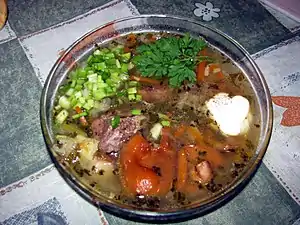Shchi
Shchi (Russian: щи, IPA: [ɕːi] (![]() listen)) is a Russian-style cabbage soup. When sauerkraut is used instead, the soup is called sour shchi, while soups based on sorrel, spinach, nettle, and similar plants are called green shchi (Russian: зелёные щи, zelyoniye shchi). In the past, the term sour shchi was also used to refer to a drink, a variation of kvass, which was unrelated to the soup.[1][2]
listen)) is a Russian-style cabbage soup. When sauerkraut is used instead, the soup is called sour shchi, while soups based on sorrel, spinach, nettle, and similar plants are called green shchi (Russian: зелёные щи, zelyoniye shchi). In the past, the term sour shchi was also used to refer to a drink, a variation of kvass, which was unrelated to the soup.[1][2]
 A serving of shchi. This variant contains saffron milk-caps, a type of mushroom | |
| Type | Soup |
|---|---|
| Place of origin | Kievan Rus |
| Main ingredients | Cabbage or sauerkraut |
History
Traditionally, shchi appeared in Kievan Rus around 9th century, soon after cabbage was introduced from Byzantium. The recipe, however, differed in many aspects and was not popularized until late 16th century Russian Tsardom. The original "shchi" meant a relatively easy to prepare vegetable blend (potage) peasants used to boil in a pot to "stuff oneself up" — the most popular etymological evidence suggest the word derived from Proto-Slavic съти, meaning "stuffed" (i.e. "full with food").
By the 10th century, shchi became a staple food of Eastern Slavs, and a popular saying sprang from this fact: "Щи да каша — пища наша." (Shchi da kasha — pishcha nasha "Shchi and kasha are our food"). Meat (beef, pork, lamb, or poultry), mushrooms, flour, and spices became ingredients as well. Cabbage and meat were cooked separately and smetana was added as a garnish before serving. Shchi is traditionally eaten with rye bread.[3][4]
Over time, as the Golden Horde split Eastern Slavs into "east" and "west" regions, and the Grand Duchy of Moscow has been formed, flour became rare and was excluded from the recipe. The spice mixture was enriched with black pepper and bay leaf. Meat was sometimes substituted with fish, while carrot and parsley could be added to the vegetables. The water-to-cabbage ratio varied and whereas early shchi was often so viscous that a spoon could stand in it, more diluted preparation was adopted later.[3][4]
Today, several variations exist: in Russia, shchi is more popularly eaten with beef, while pork is a more common meat for shchi cooked in Ukraine.
Linguistics
The two-letter word щи contains the letter щ, which is absent in most non-Cyrillic alphabets and is transcribed into them with several letters. In German, щи becomes eight letters, Schtschi.[5][6]
See also
References
| Wikimedia Commons has media related to Shchi. |
- S.I. Ozhegov (1949–1992). "Щи". Dictionary of the Russian Language (Ozhegov) (in Russian). Retrieved 2016-04-06.
- Vladimir Dal (1863–1866). "Щи". Explanatory Dictionary of the Live Great Russian language (in Russian). Retrieved 2016-04-06.
- William Pokhlyobkin (2002). "Щи". Кулинарный словарь (in Russian). Центрполиграф. ISBN 5-227-00460-9.
- William Pokhlyobkin (2007). "Щи". Большая энциклопедия кулинарного искусства : все рецепты (in Russian). Центрполиграф. ISBN 978-5-9524-0274-4.
- Cremat (1894). Wortschatz und phraseologie der russischen sprache: mit grammatischen erläuterungen. Praktisches hilfsbuch zur erlernung des russischen. R. Gerhard. Retrieved 22 February 2011.
- Karl Baedeker (Firm) (1892). Russland: Handbuch für Reisende. K. Bædeker. p. xxvi. Retrieved 21 February 2011.
.jpg.webp)
